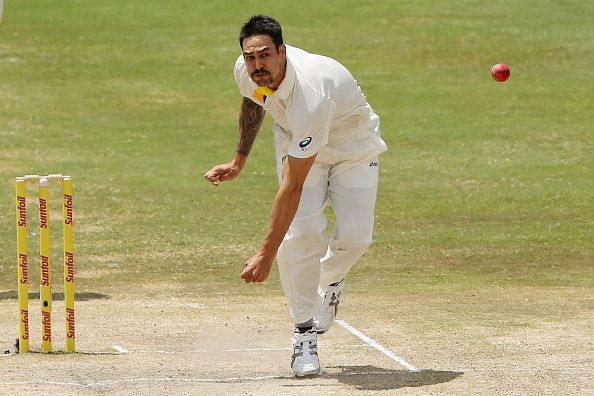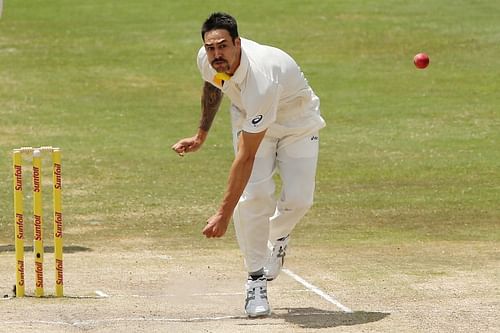
Mitchell Johnson: Re-igniting the lost spark of fast bowling

In a Pace Australia camp at Brisbane in 1998, a group of aspiring international bowlers were being watched by none other than Dennis Lillee. Many youngsters had their shot at it with the hope that they may be able to impress the legendary fast bowler and learn something from the experience. It was all mundane, though. But one fast bowler, with love for tennis, managed to impress Lillee to an extent that it went on to change the boy's career. He was labelled as a "once in a generation" bowler: a tag that earmarked him for future success and a tag that sticks with him to this very day
Come 2009, the spearhead of Australian bowling attack was demoted to being a first change bowler against Northamptonshire after returning with match figures of 3/200 in the second Ashes Test at Lord’s.
There is one common point between the two incidents: Mitchell Johnson.
Since its inception in 2004, the ICC Sir Garfield Sobers Trophy, in the memory of the legendary West Indian all-rounder Sir Garfield Sobers, is awarded annually to the best cricketer of a calendar year.
By winning the trophy this year, Johnson has joined his compatriot Ricky Ponting to become the only two players to have won the award twice: a feat that has not been achieved even by Dale Steyn, considered by many to be the greatest fast bowler of our times.
Goes off the track
No one has ever doubted his talents. His left-arm slinging action, something that has not been replicated by anyone so far, combined with his ability to bowl at excess of 150 kmph can deliver devastating results. But what was in doubt was his ability to maintain focus, be consistent and motivated enough to bay for blood, which top speedsters excel in.
The wrist, an integral part of any fast bowler's action, was erroneous, which resulted in him spraying balls all around when not at his best. Then followed the booing, criticism and lack of belief in his abilities. It was not that he didn't perform well at all; in fact, his poor performances were followed by some inspired spells of fast bowling. But he wasn't totally comfortable in his own skin, unsure of whether he will be playing the next match. In 2011, when he bowed out of the Test team with an injured foot and a muddled mind, he was 30. There were doubts over whether he will ever be able to play for Australia again, since there was a pack of young fast bowlers waiting for a breakthrough.
Back with a bang

Yet, in 2013, in the space of a single terrifying spell at Adelaide, he redefined fast bowling. It was his Deja vu moment, the feeling of having reached full potential. He hurled 150+ kmph thunderbolts striking the helmets, bodies, toes’ and, most importantly, the minds of the English batsmen.
In the previous Test at Brisbane, a ground naturally suited for fast bowling, he had taken 9 wickets; it was also his comeback to the team after a year. But what he did in Adelaide was unprecedented. To watch a terrifying spell of fast bowling is one thing. To conjure that on a flat pitch where other bowlers have been clueless is quite another. In that innings, he dismissed 7 English batsmen with 4 of them being bowled, thereby proving that he can target the stumps as good as he can target a batsman's head. Spells of that kind produced by Mitchell Johnson cannot be summed up in a single sentence.
But it wasn't a sojourn. He was there to stay. He continued the performance right throughout the Australian summer raking up 37 wickets and whitewashing the English cricket team 5-0 in the process. In the following series against South Africa in their own backyard, he delivered a stellar performance to help his team win the series.
Reigniting the lost spark of fast bowling
Cricket is a game full of delightful and breathtaking sights: the scintillating drives, the unbelievable catches, the astounding art of spin bowling and more. But nothing thrills quite like speed. Watching a genuine fast bowler bowl in his full glory is probably the greatest sight in world cricket. When a batsman faces a speedster in full flow, it is like a man against nature at its mightiest. A case of calm before a storm. And before the batsman realises, the inevitable occurs.
What makes Johnson so special is that when batsmen face him it looks like they aren't getting enough time to play their shots.Yes, he is fast, but there have been bowlers faster than him. There is something else about the Australian. His point of release of the ball is such that it reduces the time available to the batsman.The brain takes milliseconds to measure the direction, length and line of the ball to play the requisite strokes. But the difference of milliseconds that occurs when facing Johnson can hamper that process, sometimes leading to panic. It can create doubts about your own batting.
In the span of 7 Tests, Johnson had reignited the fear of fast bowlers in the minds of the batsmen throughout the world, something which made the pacers of the yesteryears such a frightening prospect. With performances reminiscent of legends like Jeff Thomson, Malcolm Marshall, Michael Holding and Lillee himself, the 32-year-old has finally joined the ranks of those rare fast men his mentor had promised long ago that he would.